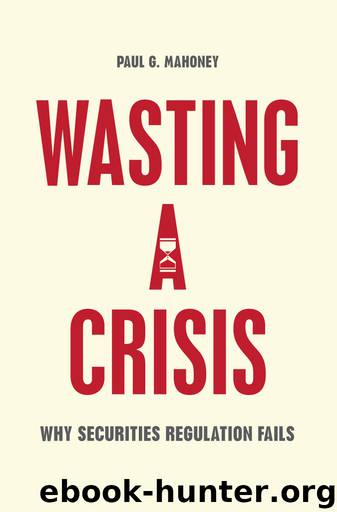Wasting a Crisis: Why Securities Regulation Fails by Paul G. Mahoney

Author:Paul G. Mahoney [Mahoney, Paul G.]
Language: eng
Format: epub, pdf
Publisher: University of Chicago Press
Published: 0101-01-01T00:00:00+00:00
CHAPTER SIX
Was Market Manipulation Common in the Pre-SEC Era?
Parts of this chapter were previously published as Paul G. Mahoney, “The Stock Pools and the Securities Exchange Act,” Journal of Financial Economics 51 (1999): 343–69, and Guolin Jiang, Paul G. Mahoney, and Jianping Mei, “Market Manipulation: A Comprehensive Study of Stock Pools,” Journal of Financial Economics 77 (2005): 147–70. Reprinted with permission of Elsevier B.V.
Today we view the federal securities reforms as motivated primarily by the desire to improve disclosure standards. However, securities market critics of the 1930s saw market manipulation as the fundamental problem. The preamble to the Exchange Act asserts that “frequently the prices of securities . . . are susceptible to manipulation.” That conclusion was based on the Senate Banking Committee’s stock market investigation of 1932–34, known as the Pecora Hearings after chief counsel Ferdinand Pecora.
The primary evidence of manipulation from the Pecora Hearings was the existence of so-called stock pools. These were agreements among groups of active traders who combined their funds to purchase and then sell a particular stock. The purpose of the pools, according to the committee report (known as the Fletcher Report), was to buy a specific stock in order to drive up its price, then to sell the overpriced stock to public investors prior to the inevitable price decline.
Galbraith (1979, 79) provides the canonical description of a stock pool:
The nature of these operations varied somewhat but, in a typical operation, a number of traders pooled their resources to boom a particular stock. They appointed a pool manager, promised not to double-cross each other by private operations, and the pool manager then took a position in the stock which might also include shares contributed by the participants. This buying would increase prices and attract the interest of people watching the tape across the country. The interest of the latter would then be further stimulated by active selling and buying, all of which gave the impression that something big was afloat. Tipsheets and market commentators would tell of exciting developments in the offing. If all went well, the public would come in to buy, and prices would rise on their own. The pool manager would then sell out, pay himself a percentage of the profits, and divide the rest with his investors.
Download
Wasting a Crisis: Why Securities Regulation Fails by Paul G. Mahoney.pdf
This site does not store any files on its server. We only index and link to content provided by other sites. Please contact the content providers to delete copyright contents if any and email us, we'll remove relevant links or contents immediately.
Killers of the Flower Moon by David Grann(3753)
Machine Learning at Scale with H2O by Gregory Keys | David Whiting(3648)
Oathbringer (The Stormlight Archive, Book 3) by Brandon Sanderson(2645)
Will by Will Smith(2584)
Once Upon a Broken Heart by Stephanie Garber(2529)
Guns, Germs and Steel by Diamond Jared(2204)
Borders by unknow(2119)
It Starts With Us (It Ends with Us #2) by Colleen Hoover(2048)
The Room Where It Happened by John Bolton;(2034)
Friends, Lovers, and the Big Terrible Thing by Matthew Perry(2008)
The Color of Law by Richard Rothstein(1823)
HBR's 10 Must Reads 2022 by Harvard Business Review(1702)
The Strength In Our Scars by Bianca Sparacino(1700)
A Short History of War by Jeremy Black(1676)
Water Rights and the Environment in the United States by John Burch(1607)
Examples & Explanations: Administrative Law by William F. Funk & Richard H. Seamon(1553)
515945210 by Unknown(1524)
Pharmacy Practice and The Law by Richard Abood(1496)
That Every Man Be Armed by Stephen P. Halbrook(1480)
